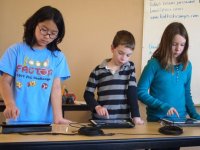Teaching and Learning: Using iPads in the Classroom
iPad features to assist in classroom learning as well as apps to include in curriculum.
Your content has been saved!
Go to My Saved Content.Updated 01/2014
If I had thirty iPads in my class, what would I do with them? How would I use them to help my students learn better and help me teach better? Perhaps a better question is what would I do with them that I could not do with other tools that are available and cheaper? Certainly iPads are cheaper than computers, desktop or laptop, and they are more mobile.
Speaking of computers, they were supposed to be the transformation of teaching and learning as we know it. In some ways there has been a transformation, but the basics of teaching and learning have remained unchanged. Perhaps, the iPad will be the tool that really does transform classroom practice. With that, I'd like to share some of the unique features of the iPad and apps, some free, to take advantage of and explore.
Kinesthetic Learners
The iPad has a number of unique features that provide for interesting possibilities in teaching and learning. The motion sensor of the iPad has a number of intriguing applications to learning. Most students today would be classified as bodily-kinesthetic learners. The motion sensor allows students to use their hands in guiding the iPad to equilibrium, balance skills, or remote control of real or virtual robotics, hovercraft, or other vehicles. Students can use the Clineometer app for measuring the level of a wall, or surface, and also the precise angles of incline, or decline. With the internal accelerometers in the iPad, physics experiments of acceleration or change in force can be measured. Imagine taking the iPad with you on a roller coaster ride. Imagine calculating angles and force and then shooting odd birds from a slingshot, destroying buildings and colliding with green pig heads (ever heard of Angry Birds?) Rubberized iPads and iPods in gym class can measure levels of exertion, balance, and repetitions.
As a completely portable learning tool, the iPad camera allows documentation to be taken to a whole different level. An app called Field Notes LT not only allows students to take copious notes of their observations, it attaches the date, time, GPS location and photographs of what is observed. These notes can be instantly shared, collaborated, and published in the field.
Students can also attach videos, and voice recordings to their field notes. They can dictate to the iPad using the Dragon Dictation app and it will type their words. With the iPads in the same network but in different locations, using the Assemblee app, students can create a collaboration web to share findings and discuss conclusions about different perspectives of the same project.
In math class the GPS of the iPad establishes locale in ways that are profound. Students can use the included Map app to calculate the distances, compare routes, and actual speeds of the westbound and the eastbound trains common in word problems. The mathematics involved with trip planning and decision-making are brought to life with actual real-time photographs, maps, and weather data provided by the Google Earth app, Big Blue Marble HD, and many others. The App called TourWrist allows students 360 degree views -- "tours" of locations of interest throughout the world. With DerManDar the students can take their own 360 degree pictures of places they visit.
Connecting Beyond the Classroom
Of course, the mobility provided by the iPad's wireless telephone connection capability allows the unprecedented access to the Internet anywhere students are. This is truly information on demand. As questions arise, students can google for clues and insights to begin their studies. Even more powerfully though, through the iPad phone connection, students can have access to volumes of primary source documents and data to help in their investigations in or out of the classroom, on the bus, in a restaurant, or at the football game.
Because iPad's do not have USB ports, disk drives or CDROM/DVD capability, methods for sharing data with other computers and devices over the Internet or "cloud" have been developed. Drop box allows students set up a personal account in which they can store iPad created documents, photos, fieldnotes, etc. And they can access those documents from any other computer or Internet capable device. Evernote will help students keep track of their notes and Mendeley will organize their research documents and let them take their research done on their computers with them, wherever they are going. The Project Gutenburg allows students to download thousands of classic books to be read on any number of free book reader apps available. With the HMH Fuse app, students have at their fingertips the entire Houghton-Mifflin Algebra One book along with exercises and tools for learning algebra.
While walking around the classroom and interacting with students, teachers can control their computers from their iPad with the Remote Mouse app. With a simple cable, teachers can use their iPads to present their unique and creative Prezi presentation made on their computer by using the iPad application called Prezi Player. The teacher can control the document by simply pinching, twisting and sliding their fingers across the face of the iPad.
Aside from the gazillions of games, tutoring, and pointless apps available for free, a diligent teacher can find treasures of apps for their iPads that engage and challenge the student minds in creative ways. Some of my favorites are Lasers Free, Trainyard EX, Play Chess, Words with Friends, and Contre Jour (not free, but worth the $.99).
How do you use iPads in the classroom to help teaching and learning?
